
© 2010-2023 by Fine Arts of the Southwest, Inc. All rights reserved.
Unauthorized reproduction or use is strictly prohibited by law.
A stunning vintage Navajo silver and “Lavender Pit” Bisbee, AZ turquoise ring by Mark Chee, c.1950’s-60’s
A truly gorgeous piece by one of the all-time greatest superstars of Navajo jewelry, Mark Chee (1904-1981). Born in
the tiny, remote one-horse hamlet of Lukachukai Arizona way out in the far reaches of the vast Navajo Reservation,
Mark Chee came to Santa Fe as a young teenager to work at Julius Gans' Southwest Arts and Crafts as a jewelry apprentice polishing stones for $5.00 a week. Due to his exceptional talent and instruction by some of the finest Navajo and Pueblo silversmiths of their day, people such as Ambrose Roanhorse, Sam Roanhorse and Joe Quintana, Chee rose rapidly becoming an ace silversmith whose pieces were constantly in high demand.
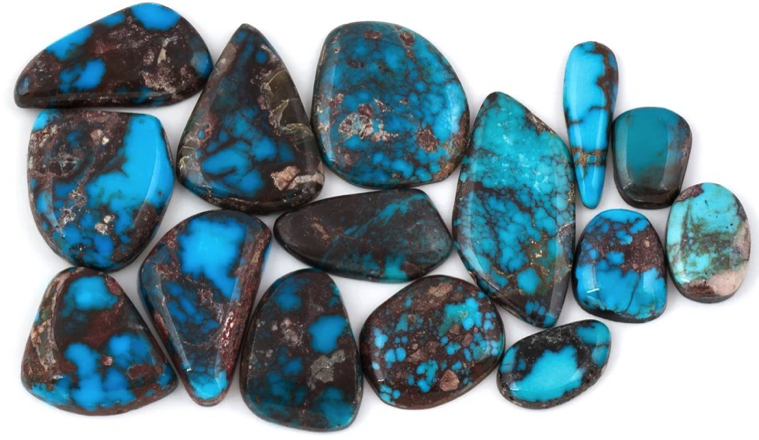
Bisbee Turquoise
Bisbee turquoise is a significant by-product of the huge Lavender Pit copper mine, which is now closed. With some of the finest turquoise coming from the section of the copper mine known as the “Lavender Pit,” where for years copper miners would bring out fine turquoise in their lunch boxes. In March of 1972 a miner named Bob Matthews was given the only lease ever granted for rights to mine Bisbee turquoise. He was said to have recovered more than 2,000 pounds of good to excellent turquoise by 1974 . Bisbee turquoise is famous for its deep blue color and its smoky black matrix, which has been described as “smoky Bisbee” and as “lavender.” Bisbee turquoise is as good as turquoise gets. In 2004 the Phelps Dodge Mining Company no longer allowed anyone near the hazardous old mine and buried the turquoise pit under 100 feet of dirt. There will be no more Bisbee mined. Any Bisbee on the market today was officially mined prior to 1974.
-Bisbee turquoise text and photo source and © Waddell Gallery, Scottsdale, AZ
“Bisbee turquoise is as good as turquoise gets.”
-Ameircan turquoise authority and mine owner, Gene Waddell
The bezel platform containing the stones is very nicely mounted on a finely-crafted triple split silver ring shank.
The finished design has a certain and interesting resemblance to a stylized standing human figure, with the smaller piece of turquoise possibly representing the head and the larger piece, the body. The exceptionally fine all-around detailing and the classic simplicity of the ring’s appearance belies the considerable complexity and difficulty of its construction. The great ones always make the really tough stuff look easy! All in all, it's a delicious and delectably precious piece, literally looking good enough to eat!
The ring measures a size 5 3/4 to 6 on a professional graduated ring sizer. The ring’s face is 1" in height and it is
5/8" in width at its widest point. It weighs a very comfortable and easily wearable 9 grams or 3/8 ounce. The ring is in remarkably fine original vintage condition, particularly for its age with a slight scratch or ding here and there.
It has developed a lovely soft patina with age and use. The ring is properly and beautifully signed on the inside with
Mark Chee’s customary last name inside a profiled bird’s head hallmark.
This stunning ring is a classic historic piece with classic historic stones, made by a classic historic
Native American artist, one of the truly greatest of all time.
SOLD
Chee always worked in a completely traditional manner using a simple set of tools which he mostly made himself and always insisting on using only the finest stones as he did here with this terrific silver and “Lavender Pit” Bisbee, Arizona turquoise ring. “Lavender Pit” Bisbee Arizona turquoise is one of the world’s great turquoises well-known and highly-prized for its deep purplish--black smokey “Lavender” matrix and Mark Chee made wonderful use of it here, setting the two large polygon-shaped, hand-cut and faceted Bisbee stones with their deep penetrating blue color in lovely old-style "foldover" type silver bezels atop a silver bezel platform and further highlighting the stones and their bezels with an applied round silver “raindrop” on either side.
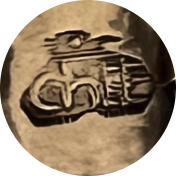
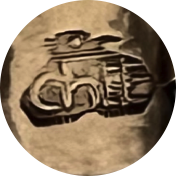
At left, Navajo silversmiths at Julian Gans' Southwest Arts and Crafts, Santa Fe, NM, 1935. Mark Chee is pictured second from left. At right, Mark Chee at work, c. 1940's
Left and right photo source and © Frasher's Fotos

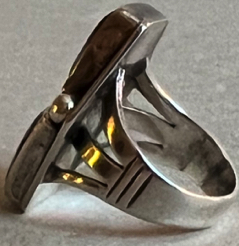
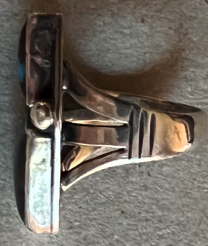

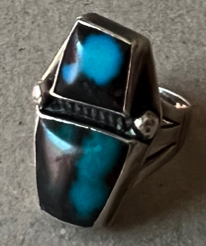
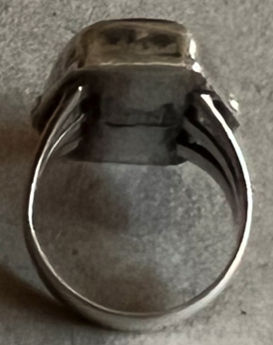
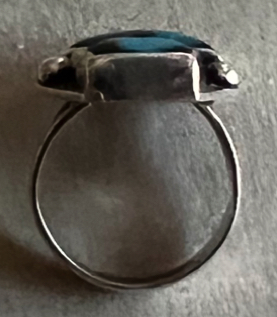
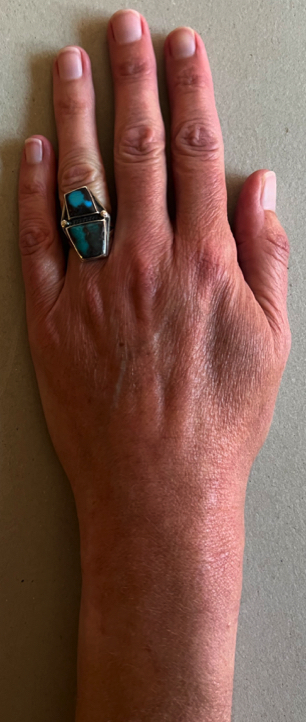


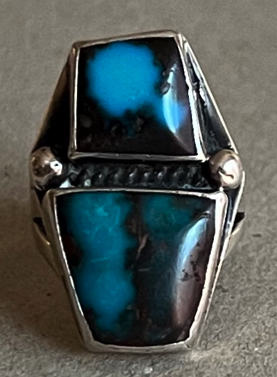
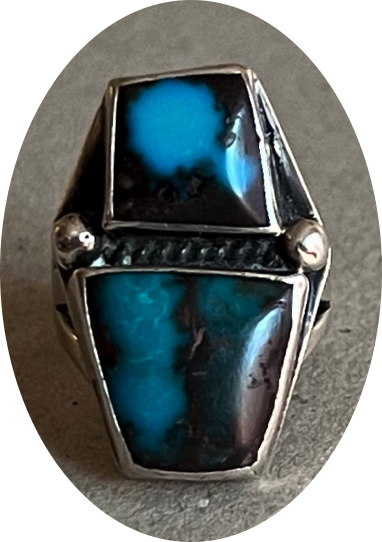
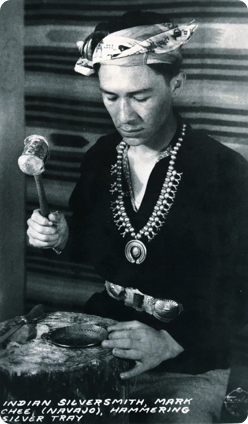
The ring pictured with a "Lavender Pit" Bisbee turquoise specimen rough.